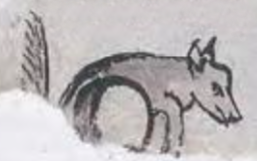Coyohuacan (Osu13r)
This compound glyph for the place name Coyohuacan (“Place That Has Coyotes,” Coyoacán, today) has two principal elements, a gray coyote (coyotl) and a hole (coyoctli) occupying most of the middle of the body of the animal. The coyote is sitting in profile, facing right, with its tail standing straight up and its head bowing somewhat. It is presented in profile, facing toward the viewer's right. The lower part of the coyote is not visible, as the folio is worn away at the bottom. The locative suffix (-can), which says "where," is not shown visually. The "coyoc-" of the hole provides a phonetic reinforcement for the "coyo" of coyote. This helps clarify that this is not a dog. Erik Velásquez García (2019, 77) discusses this KOYO-KOYO combination of logogram (coyote) and rebus (hole). The -hua- is a possessor suffix that attaches to nouns. This is to say that this is a place that has coyotes.
Stephanie Wood
The contextualizing image shows a Nahua man, presumably from Coyohuacan (or Coyoacan, today, which is south, but now part of Mexico City), paddling a canoe full of what appear to be gray adobe bricks (the term xamitl does not occur in this particular place, but it is mentioned elsewhere in the document). A notation for the number ten conveys that ten men with canoes full of adobes had been drafted by the Spaniard, Dr. Vasco de Puga, to bring him these materials for a construction project. This manuscript is full of examples of labor provided to Dr. Puga without remuneration. Workers were also mistreated.
Stephanie Wood
1551–1565
Jeff Haskett-Wood
coyotes, animales, transportar, cargar adobes por acalli, boats, canoas, lanchas, remar, servicio, trabajo, nombres de lugares

Coyohuacan, an important altepetl south of Mexico City, https://nahuatl.wired-humanities.org/content/coyohuacan
coyo(tl), coyote, https://nahuatl.wired-humanities.org/content/coyotl
xami(tl), adobe, an earthen brick, https://nahuatl.wired-humanities.org/content/xamitl
-can (locative suffix), https://nahuatl.wired-humanities.org/content/can-2
Donde Tienen Coyotes
Stephanie Wood
Library of Congress Online Catalog and the World Digital Library, Osuna Codex, or Painting of the Governor, Mayors, and Rulers of Mexico (Pintura del Gobernador, Alcaldes y Regidores de México), https://www.loc.gov/resource/gdcwdl.wdl_07324/. The original is located in the Biblioteca Nacional de España.
"The Library of Congress is unaware of any copyright or other restrictions in the World Digital Library Collection. Absent any such restrictions, these materials are free to use and reuse." But please cite the Biblioteca Nacional de España and this Visual Lexicon of Aztec Hieroglyphs if you use any of these images here or refer to the content on this page, providing the URL.




